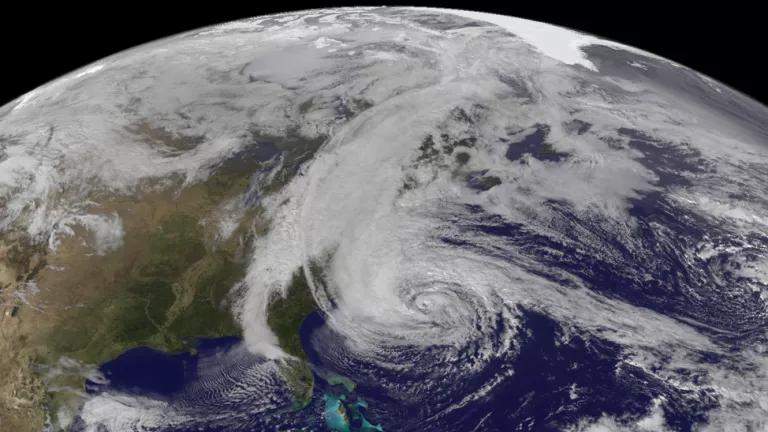Hurricane Season Starts Without Flood Insurance Reforms

Hurricane season has officially started, and if this year’s season causes anywhere close to the level of damage wrought by the last, the National Flood Insurance Program (NFIP) will be pushed well beyond the breaking point. The NFIP is in desperate need of reform and Congress has left itself less than two months to accomplish this heavy lift before the program expires on July 31.
Congress must stop kicking the can down the road by issuing short-term extensions, which they have done six times since the program was scheduled to expire last September. The NFIP has major shortcomings that demand solutions. These shortcomings include structural issues that prioritize rebuilding in the same vulnerable place rather than moving out of harm’s way, a lack of adequate transparency around flood hazards, outdated and backwards-looking flood maps, and a failure to charge premiums that do not reflect the actual flood risk insured properties face.
Priorities for 2018 NFIP Reauthorization and Reform
The 2017 hurricanes exposed the vulnerability of the program and underscored why Congress must prioritize substantial NFIP reform, not just reauthorize the same broken program. Such reform should include the following:
Providing more assistance to help homeowners move out of harm’s way
Congress, through the NFIP, should direct FEMA to provide more assistance to homeowners who would like to relocate, instead of repeatedly rebuilding after every flood. Implementing such a program would empower homeowners to escape the cycle of flooding and rebuilding, and would lessen the NFIP’s financial exposure by removing some of these continuously-flooded properties from its books. The NFIP has historically focused on rebuilding flooded properties—often multiple times―instead of helping homeowners move out of harm’s way. In the United States, more than 30,000 properties have been flooded an average of five times each, and then have been rebuilt each time through the NFIP. Some of these properties have flooded more than thirty times.
Fortunately, a bipartisan group of Senators and Members of the House of Representatives have introduced legislation(S. 2862 and H.R. 5846) that would determine how to provide faster assistance to repeatedly-flooded homeowners who would like to move to higher ground. The legislation requires the U.S. Government Accountability Office (GAO) to conduct a comprehensive evaluation of FEMA’s current practices for funding the purchase of properties and provide recommendations for making the process more efficient and effective. Additionally, GAO will examine alternative methods for conducting buyouts more efficiently, like pre-approving and guaranteeing interested homeowners a buyout before a flood occurs.
Mandate greater disclosure and transparency of flood risks and NFIP data
Congress must mandate greater disclosure and transparency of flood risk data. Homeowners should have the right to know about their property’s history of flood damages. Too often, people buy a home only to find out later that it is susceptible to flooding. If previous owners filed an NFIP claim, FEMA has key flood history for the property. Homeowners, whether or not they currently have NFIP coverage, should have a right to this information. Providing the flood history of a property can help homeowners make informed decisions.
Additionally, Congress should ensure greater accessibility and transparency of NFIP data to accurately inform the broader public (including researchers, city planners, and emergency responders) about flood risk. The public has a right to know where flood damages occur, the cost of those damages, and what communities are doing to reduce their vulnerability to flooding. Congress should require FEMA to make this information available. This information would provide a better understanding of flood risk and the exposure faced by the NFIP, which is especially important as sea levels rise and extreme rainstorms become more common—a key time to encourage more risk-adverse behavior and mitigation actions.
The House of Representatives has already provided for such reforms in the “21st Century Flood Reform Act” (HR. 2874).The Senate must follow their lead and enact these commonsense measures so homeowners and communities can better prepare for and protect against future floods.
Continue to move the program toward risk-based rates
Congress must ensure the program continues to move toward full risk-based rates to achieve a financially stable program, and to impress upon homeowners their true risk of flooding. Today, policyholders under the NFIP pay artificially low insurance premiums that fail to reflect the likely risk of flooding. A recent report by the nonpartisan Congressional Budget Office reveals that taxpayers effectively subsidize 85 percent of NFIP properties exposed to storm surge from coastal storms. Congress must not roll back the current move toward risk-based rates, but should provide an affordability mechanism, which provides means-tested assistance divorced from the premium, to assist low-income policy holders.
The Federal Emergency Management Agency (FEMA) recently released a report describing how the federal flood insurance program could be reformed to provide low-income households affordable options for insurance coverage. The report contains some great proposals for helping low-income homeowners afford flood insurance without compromising a move towards actuarially-sound rates, but flood insurance is just one of many tools for managing flood risk. Any proposal for affordable insurance coverage must also include greater access to resources that can help low-income families get out of harm’s way, like grants for voluntary buyouts.
Improve the flood mapping program
FEMA’s flood maps are more than just mechanisms to set insurance rates. These maps provide risk information and enable communities to make informed decisions about their flood vulnerability. Unfortunately, too many flood maps are out-of-date, and those that are current still fail communities by not depicting future conditions like sea level rise. Congress should ensure FEMA’s mapping program is capable of meeting this burden and is incorporating advisory layers depicting future flood risks.
Floods Are Getting Worse
As floods and flood damages continue to rise, now is the time for climate-smart reforms to the NFIP. The program should be the linchpin of the nation’s efforts to prepare for and adapt to escalating flood risks, not just a contributing factor. Congress has the power to make that happen. Now it just needs the resolve.

